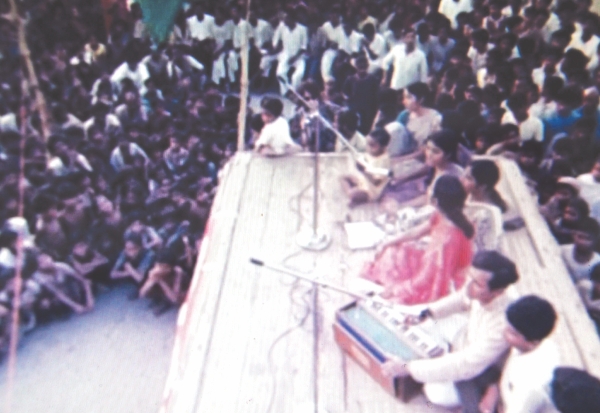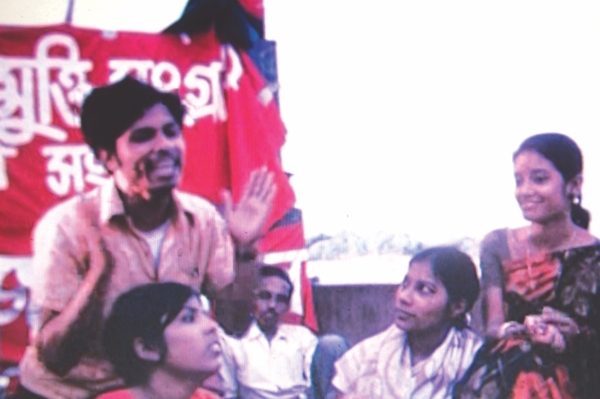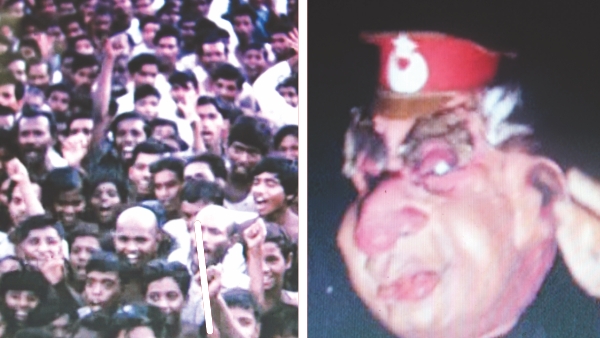
Inside
|
Muktir Gaan:
An End to Revisionist History
NAEEM MOHAIEMEN pays tribute to Tareque Masud and Mishuk Munier, killed in last month's road collisions, with his 1997 piece on Muktir Gaan.
Muktir Gaan (Song of Freedom) is the first feature length documentary on the Bangladesh liberation war. In 1971, the Bengali revolt against Pakistani domination and the subsequent army crackdown, captured world headlines on an unprecedented scale. The newspapers dubbed it "The Bengali Holocaust". For a war-weary generation in the West, already on edge from Vietnam War protests, the genocide in the subcontinent inflamed passions and triggered agitation against US arms policy, blockades against Navy ships and guerrilla theatre in front of the White House and Hyde Park.
Yet, for an event that inspired such passionate and seemingly selfless (unlike Vietnam, there were no Americans coming home in body bags) acts of defiance in the West, the Bengali liberation struggle disappeared from radar screens with haste. There were no collected "guerilla poems", no romantic novels with heroes parachuting into the middle of occupied Dhaka, no anniversary articles in the New York Times.
The media erasure was helped by the fact that the liberation struggle's charismatic leader Sheikh Mujib could not translate the war's success into a stable country. His 1975 assassination left a vacuum and no larger-than-life leader to glamorise. Ultimately, media sources also moved by their usual logic. With the end of the war, there were no more dead bodies -- reporters got bored and moved on.
 Photo: "Muktir Gaan"
Photo: "Muktir Gaan"
Lear Levin
Filmmaker Lear Levin, whose work is the core of Muktir Gaan, discovered the brevity of media attention span the hard way. When he set off to make a film on Bengali guerrilla camps in India, the struggle was the cause of the moment. Protesters had set up camp inside mock cement pipes outside the White House (representing the Bengali refugees huddled in construction pipes in India); Bill Moyer and his men had created human flotillas to prevent US Navy ships from leaving harbour; Chicago witnessed a sari-clad white woman on a crowded street carrying out guerrilla theatre; George Harrison and Joan Baez both had hit songs with Bangladesh in the title; and Edward Kennedy was clobbering Nixon over arms shipments to Pakistan. By the time Levin returned with over 20 hours of footage from India and Bangladesh, however, the media and the public had moved on. Cambodia, Watergate, the continuing struggle in Vietnam and a host of other events merged to make the obsession with Bangladesh a short-lived moment in the history of media frenzies.
Disheartened by lack of interest in his project, Lear Levin consigned the film stock to a New York basement. After Tareque and Catherine Masud married, they moved to New York and eventually tracked down the 20-year-old trail of Levin. Not only did the Masuds find Levin, they also received permission to use the footage without any royalty. Compared to the exorbitant prices the filmmakers had to pay for the few minutes of archival news-reports obtained elsewhere, Levin's gift made the film possible.
A process of reverse script-writing began, with the Masuds extracting sequences from 20 hours of footage to piece together the story of a travelling band of Bengali musicians collecting funds for the war effort and raising the spirits of the guerrillas. Along the way, the husband-wife team found assistance from a variety of activists in the Bengali community in the US, including invaluable help in raising the seed money from fund-raisers. For a community that was struggling for economic stability in the US, being instrumental in a large-scale film project was unusual at that time.
 Photo: "Muktir Gaan"
Photo: "Muktir Gaan"
Lyrics and chants
The finished film is the story of a singing cultural troupe travelling through refugee camps and eventually crossing the border into liberated zones of Bangladesh. Interspersed with this is invaluable documentary footage, including Sheikh Mujib's famous speech of 7th March 1971 ("This time the struggle is for freedom" -- the first time Mujib publicly echoed the radical student factions' long-running demand for total separation from Pakistan). Also here is the spectacle of Zulfikar Ali Bhutto, who precipitated the crisis by rejecting the Bengali victory in the 1970 Pakistan election, tearing up a United Nations resolution and storming out -- with a listless George Bush, then Ambassador to the UN, looking on.
The troupe's song performances are gems of folk history, and the enthusiasm of the refugees at various shows is captured with a minimum of intrusiveness. A standout is the kirthan-style song where Swapan Chowdhury alternately goes into a trance and dissolves the chorus into an orgy of applause. This song's lyrics (rewritten by Tareque Masud) are also the film's sharpest barbs at the role of the Nixon administration in trying to send the Seventh Fleet to the aid of Pakistan:
But now the Pak army flees for their lives and with them flees the Seventh Fleet
Then Yahya Khan cries out
Tell me, oh tell me,
where did Uncle Sam go?
But now the thugs flee,
And with them flee the collaborators
Then General Niazi cries out
Tell me, oh tell me,
where did Uncle Sam go?
Other songs are familiar patriotic songs, mixed with chants of "Destroy the Pak invaders". The lyrics alternately affirm love for the land and proclaim universal brotherhood -- themes popularly identified with Bengali nationalism of the late 1960s:
From Jessore, Khulna, Bagura, Pabna,
Dhaka they hail
Not Hindus, Not Muslims, they are all
Bengalee
The sad irony of these lines and the presence of a large number of Hindu performers in the cultural troupe seems to have escaped audiences at most screenings. Given the recent surge in Islamism in Bangladesh politics (with even Sheikh Mujib's formerly secular Awami League adopting visibly Muslim trappings), and the continuous diminishing of the Hindu presence in Bangladesh's cultural-political scene -- the film is a sad reminder that although the 1971 liberation struggle was celebrated globally because of its secular beliefs (one poster proclaimed: "Hindus, Christians, Buddhists, Muslims of Bengal are all brothers"), subsequent governments of free Bangladesh failed to approach any of the ideals declared on the battlefield.
The troupe's puppet theatre illustrates how Pakistani leaders like General Yahya Khan were transformed into larger-than-life villains. Here we see villagers -- who had possibly never seen a picture of Yahya -- chuckling at a cowardly and perpetually drunk puppet with the universally recognisable moustache and military cap. Filmed at night by the light of a bonfire, these vivid scenes are remarkable in the context of footage that is now over 25 years old. Also powerful are the Dantesque sequences where the camera goes roving down the hallways of refugee camps.
The weaker moments in the film are the scenes of the singers relaxing off-stage, where the dialogue is possibly staged for Levin's camera. These are also the points where the lines between documentary and make-believe become blurred. Although the film clearly states up front that it is a "film based on footage shot by Lear Levin", the overall production maintains a documentary realism, with the exception of the few staged scenes of dialogue.
Offering a contrast to this is the parrot the troupe collects on its travels. Troupe members try to teach the bird Bengali, starting with the ultra-dainty "When evening comes slowly" couplet, and ending up with the slogan made famous by Sheikh Mujib: "Joi Bangla!". The parrot fails to learn either the gentle lyrics or the street chant -- in real life, not everything happens on cue.
Middle class liberation
Muktir Gaan succeeds as an affectionate portrait of the travelling musicians in war-torn Bangladesh. The subtext that is not explored fully, but is nevertheless clearly present in the final scene, are the class differences among the Bengali refugees and the singing group. The troupe members are, for the most part, from middle-class backgrounds. Yet, here in the course of the film, they mix with village refugees, farmers and foot soldiers. There is some awkwardness in these interactions, as when the troupe embraces a group of soldiers in a liberated zone. In these few moments, one of the fundamental contradictions of the war effort is visible on screen.
The Awami League's anti-Pakistan stance was the expression of a nascent Bengali middle class and their antagonism toward the West Pakistani middle class and elite. By the time the war broke out, the conflict had become Bengali vs. non-Bengali -- class differences were temporarily forgotten as peasants fled across the border in the same cattle-carts as city dwellers.
Throughout the nine months of conflict, the middle class leadership repeatedly declared the struggle to be for the "Workers and Farmers of Bengal". But as soon as the war effort was over, each faction retreated to its own camp. With a nation of their own, the Bengali middle class prospered, the peasantry who returned across the borders of "free" Bengal found their status unchanged.
Some of the cultural troupe members are now well-placed members of Bangladesh society, but a search for some of the peasants seen on screen would probably place them in the same straw huts they lived in before the war. Not surprisingly, conspicuously absent at the New York screenings of Muktir Gaan which I attended were the city's large Bangladeshi working class population. Ritual celebration of the war remains a middle class phenomenon -- the only class that was fully liberated in 1971. Masud knows all this of course, and I hope he will explore it in future films, where he is not constrained by available footage.
 Photo: "Muktir Gaan"
Photo: "Muktir Gaan"
Too much authenticity
The challenge faced by the Masuds in putting the film together paled in comparison to the difficulties they confronted in attempting to release the film in Bangladesh. Inevitably, the film ran into the inter-party conflict that characterises the Bengali political establishment's approach to the history of independence.
Narratives glorifying the liberation war have traditionally helped the Awami League, whose strongest nostalgic connection to the voting population is through its role as leader of the liberation struggle. The League's traditional nemesis, the Bangladesh Nationalist Party (BNP), attempts to weaken the AL's hold on "pro-liberation" sentiment by emphasising their founder General Ziaur Rahman's links to the struggle. A long-running and often raucous debate -- played out in newspapers, speeches and parliament -- focuses on Zia's famous declaration of independence on Chittagong Radio. In symbolism-obsessed Bangladesh, Zia's radio announcement is brandished as proof that he first declared independence, although the AL repeatedly points out that the announcement was made in Sheikh Mujib's name.
Muktir Gaan stepped into this charged battlefield and ran immediately into the BNP government-controlled censor board. With its footage of Mujib's speech, and shots of soldiers yelling his name, the film was blocked as a partisan version of history. The sequence with a radio playing Zia's speech soothed the BNP stalwarts, but here the film ran into the unique problem of being too authentic. In recent years, the BNP had started publicising a staged version of the speech with the reference to Mujib cut out. But here was the original tape, recovered in Germany from a former employee of war-era Free Bengal Radio, with the reference to Sheikh Mujib as "great national leader" intact.
In the end, several factors worked in favour of the film. In 1995, the BNP government was engulfed by street protests as part of a two-year opposition campaign demanding neutral elections. Facing diplomatic and military pressure to yield to the election demands, the government seemed to have lost appetite for a showdown over Muktir Gaan. Newspapers such as the popular Bhorer Kagoj played a key role by running feature stories with stills from the film. The Censor Board clearly recognised that newspaper reports were building growing public awareness of a film that was being called a "masterpiece", but facing suppression from the Board.A Bengali writer, who assisted with the film, is of the opinion that the presence of Catherine Masud served as a deterrent to the scissor-wallahs. This was not a local production from struggling artists, which could easily be squashed -- the censor board was aware of the film's international linkages. Already smarting from the Taslima Nasrin debacle in 1994, where the BNP had seriously underestimated the scope of international attention, the government was anxious to avoid another confrontation. In the end, the film received the long-awaited screening certificate with no visible compromise from the filmmakers.
As feared by the government, the film became a massive propaganda windfall for the Awami League. Muktir Gaan was shown to wildly enthusiastic and overflowing crowds all over the country. Screenings were preceded by throngs of young men yelling "Joi Bangla". Showings at the army cantonment theatre, Garrison, were attended by the Army Chief General Nasim and enthusiastic jawans. The Awami League, quick to recognise the huge publicity value the film had for them, distributed the soundtrack to campaign offices. Begum Zia's government made a half-hearted try at banning the film, starting with the Intelligence Forces' attempt to withhold issues of Bhorer Kagoj carrying in-depth coverage of the film. By then, however, public awareness of the film was too high for them to proceed further.
 Photo: "Muktir Gaan"
Photo: "Muktir Gaan"
Revisionist history
Beyond the artistic value of Muktir Gaan, the release of the film is a landmark event in a country struggling to build a coherent version of its history. Over the last two decades, every government has suppressed discussion on the liberation war to protect its own vested interests -- sometimes the civil servants who stayed in their posts through the war, sometimes army officers who feared that glamorising the war would help the Awami League, and sometimes the Islamists of Jamaat-e-Islami who had actively helped the Pakistan army by forming militia and death squads.
Now, following on the footsteps of Muktir Gaan and Channel 4 (UK)'s celebrated War Crimes Trial documentary, there is a renewed interest in documenting the liberation war. This upsurge coincides with the Awami League's recent election victory -- its first time in power since Mujib's 1975 assassination. Suddenly, there is a rush to prove oneself a die-hard Mujib-ist. You may expect a flood of documentaries and books on the late leader to follow.
Certainly, a history of Bangladesh's liberation needs to focus on the Awami League and Sheikh Mujib's role in the struggle. But in the midst of all the fanfare, will anyone raise the uncomfortable questions about the inherent contradictions of a war fought with peasant cannon-fodder, yet led by the bourgeoisie-dominated Awami League; about the deep-rooted distrust between the leftist guerrillas and pro-Mujib factions; the tacit understanding between Indira Gandhi and the AL about the need to destroy the Naxalite-influenced Sharbahara Party; and the subsequent persecution of JSD (Jathiyobadi Shamajthanthrik Dal, or the National Socialist Party) and other left forces which represented the only opposition at that time to the post-1971 Mujib government?
Without an analysis of all sides of a remarkably fluid struggle, a renewed interest in the history of Bangladesh's independence may not be substantially different from the propaganda exercises of the past.
Dedicated to the memory of Tareque Masud (1956-2011) and Mishuk Munier (1959-2011).
This article was originally published in 1997 in SAMAR (South Asian Magazine for Action & Refection) and HIMAL.
Naeem Mohaiemen is a writer and visual artist working in photography and film [naeem.mohaiemen@gmail.com].